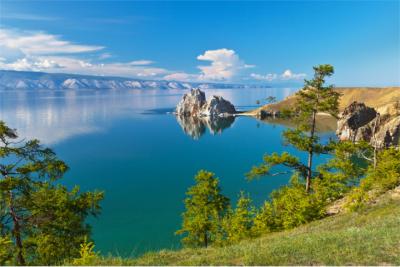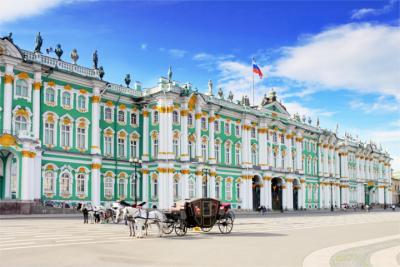Travel Offers
Travelmyne Featureprint
Distance
Lake Baikal - Siberia's Sacred Sea
Lake Baikal, the world's deepest and oldest lake, is a natural beauty in the south-east of Siberia. Its unique fauna, breathtaking landscape and compelling culture fascinate travellers to the present day.

Geography - The deepest and oldest lake on earth
Lake Baikal is 1,642 metres deep and 25 million years old and lies in the south-east of Siberia. It is the deepest and oldest freshwater lake on earth. In addition, is has a water surface of 31,722 km², a maximum length of 673 kilometres, a maximum width of 82 kilometres and a water volume of 23,615.39 km³, which makes it the world's largest lake. Altogether 336 rivers and streams flow into Lake Baikal. Its greatest tributaries are the Upper Angara River, the Angara River, the Selenga River and the Barguzin River. Geographical features are the surrounding mountain ranges (Baikal Mountains, Stanowoi Khrebet, Barguzin Range, Ulan Burgassy Range, Chamar-Daban, Eastern Sayan), the Baikal Rift Zone and the islands in the lake. The largest of the 22 islands in the lake is Olkhon Island. The climate at Lake Baikal is a continental cool temperate climate. While it is temperate to warm in summer, the winter months are characterised by temperatures around -20 °C and permanent frost. The lakes surface is covered in a thick layer of ice in the cold season.

Nature - The endemic fauna in the crystal clear water
The landscape near Lake Baikal is characterised by a breathtaking mountain panorama, wonderful coasts, beautiful beaches and a unique fauna. The surrounding forests full of larches, cedars and birches are home to animals like foxes, boars, elks, deer, wolves, brown bears and lynxes. The extremely clean water accommodates a great number of fish species (especially cottids, carps and salmon), some of which exist in no other place. Two examples are the (Baikal) omul, a type of salmon, and the Baikal oilfish. Another endemic animal species is the Baikal seal, which is the world's only freshwater seal. Numerous nature reserves and national parks have been created to protect the lakes' special fauna. In addition, Lake Baikal was declared a UNESCO World Natural Heritage site in 1996.

Culture - The shamanism of the Buryats
The area around Lake Baikal was originally settled by the Buryats, a Mongolian tribe. They practised an age-old form of shamanism, which mixed with Buddhism and Christianity later on. Their language is said to have given the world's oldest lake its name. The Buryats, their traditions, customs and beliefs are still present. This is apparent from columns made of stone and wood along the roads on Olkhon Island as well as from the Shaman Rock on Cape Burchan. The latter is a former cultic site of the Mongols as well as an offering and resting place of the highest god and was used for rituals. The columns on the islands, which are decorated with colourful ribbons or pieces of cloth, are sacred sites of the Buryats too. They express request for luck, health or forgiveness or are a tribute to a deceased person.

Experience - Enjoying the local cuisine
Lake Baikal is a place of tranquillity and silence, in which you can enjoy Siberia's impressive nature. It is livelier in the village of Listvjanka, the gateway to Lake Baikal, which you can reach by taking the Circum-Baikal Railway. The village is one of the most popular holiday resorts at the lake and accommodates several hotels, shops, souvenir shops and restaurants. The latter do not only serve Siberian and typical Russian food but also Buryat dishes. These mainly contain meat. One culinary speciality at lake Baikal is the omul. The freshwater fish is being smoked, grilled or stewed and eaten as a snack.

Activities - Camping adventures and ice skating hikes
Lake Baikal is a real paradise for active holidaymakers who want to enjoy the wonderful landscape, impressive silence and Siberia's vastness. There are many opportunities for hikes and trekking tours, for example on the Great Baikal Trail. Another intense natural experience is camping at the lakeside with relaxing silence, a wonderful mountainous landscape and a breathtaking view. Popular leisure activities in and on the water are fishing and bathing. You should know, however, that even in summer the water temperature is rarely higher than 10 °C, so that swimming in Lake Baikal does not compare to bathing in the Mediterranean Sea. In winter, you can go for a walk on the lakes' metres thick and crystal clear layer of ice, go ice fishing, ice skating or go on a sleigh ride.

Information
The best time for a trip to Lake Baikal is between June and August. At this time, the temperatures are pleasantly warm and the water can be up to 16 °C warm in the bays. If you want to do winter sports like ice skating or ice fishing, you should visit the lake in December, January or February. However, the temperatures in winter are between -20 °C and -35 °C. Travellers reach Lake Baikal by plane or by taking the Trans-Siberian Railway to Irkutsk. From there, you have to go another 70 kilometres by bus.
A trip to Lake Baikal is a great experience for active holidaymakers and adventurers. Camping at the lakeside, hiking in the surrounding mountains or ice skating on the thick, crystal clear layer of ice - Lake Baikal offers unique natural adventures in both summer and winter.




